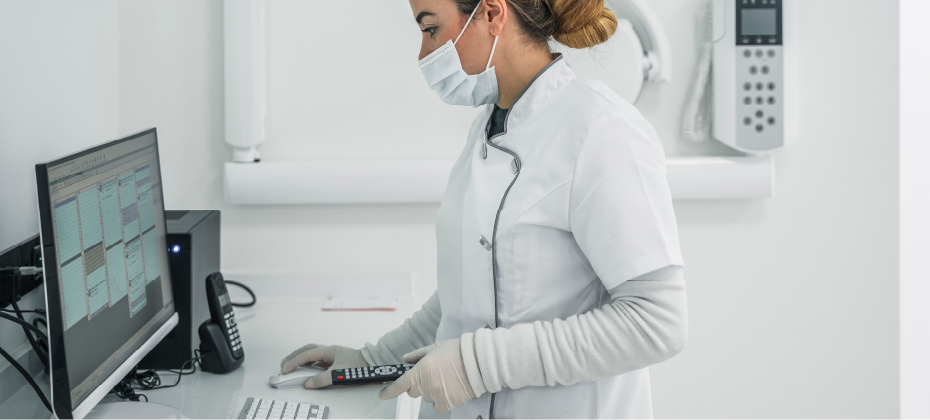Claims & Contract Management
Improve financial performance with automated, clean and data-driven medical claims management.

Product featured in this article: Coverage Discovery As of the end of March 2021, more than 53 million Americans have been fully vaccinated, allowing for cautious optimism as we prepare for the next phase of the COVID-19 journey. Unfortunately for pharmacists, the vaccination program has compounded many of the challenges of the last 12 months. Shots may be free to patients, but someone has to pay for them – and getting reimbursed is proving to be a major pain. Complicated billing processes, extra billing audits and mountains of extra paperwork, rejected claims and slow payments are not exclusive to pharmacies helping vaccinate America. With the coronavirus pandemic continuing to muddy the insurance landscape, getting hold of missing dollars is challenging. Healthcare reimbursements haven’t been straightforward for other providers either: widespread coverage loss and uncompensated care is putting extra strain on hospital revenue cycles. With the coronavirus pandemic continuing to muddy the insurance landscape, getting hold of missing dollars is challenging. Providers must find ways to quickly and accurately determine each patient’s coverage status to minimize bad debt. Navigating the complex world of post-COVID healthcare coverage What does the reimbursement landscape look like, one year on? After a long wait, elective procedures are back. But the surge in patient volumes means providers must be on their toes to keep track of coverage. The process for doing so must be streamlined and precise. Ramping up capacity to verify and check coverage without burdensome paperwork is a must. Patient intake is under pressure. More patients are coming through the doors as a result of elective services and vaccination programs (though not always to their usual facility). COVID-19 hasn’t gone away, and with pockets of infection spikes, safety remains a top priority. Capturing adequate insurance information in this context is no mean feat. Running automated coverage checks as soon as the patient arrives will minimize face-to-face contact during admissions and avoid delays. Patient access and collections staff are overburdened. Manual checks are difficult when staff are operating remotely or in a socially distanced environment, and patient information might be incomplete. Automated self-pay scrubbing can help handle the volume. A tool with built-in reporting can also offer insights on workflow and productivity, to help spot opportunities for quicker claims processing. New digital healthcare technologies aren’t always covered by insurers. Telehealth, a life raft during COVID-19, tends to be covered less often by private insurers, compared to Medicare and Medicaid. Coverage checks must factor this in to avoid errors and wasted time. Providers should opt for tools that sweep for payer updates to telehealth coverage to avoid unnecessary delays or denials. Employment levels may be inching upwards again, but tracking coverage remains a challenge as patients start new jobs with new health plans. In addition, checking for Medicare coverage in the midst of changing codes and protocols is time consuming and confusing. A third-party resource such as Coverage Discovery can look for all coverage options and make sure the right bill goes to the right payer. Find missing dollars with Coverage Discovery Hospitals, pharmacists and other healthcare providers can’t afford to continue losing money at a time when every dollar is needed to prepare for “after COVID-19.” Experian Health’s Coverage Discovery is a proven system for tracking down missing coverage quickly and easily, to avoid unnecessary revenue loss. Using billions of data assets and intelligent confidence scoring, it combs through multiple government and commercial payer accounts to maximize actionable coverage. Staff can trust the outputs and focus their attention where it’s really needed. By making coverage identification more efficient and accurate, it’s a shot in the arm for providers in need of faster reimbursements. Contact us to see how Coverage Discovery can be easily integrated into your revenue cycle, so you can maximize reimbursements over the coming weeks and months.

Many thought the end of COVID-19 was in sight with the availability of a vaccine, and while that is somewhat true, an entirely new set of issues has arrived: how to properly administer and manage the vaccine. Now that a COVID-19 vaccine is approved and underway, providers need to execute a medical billing and coding strategy to sustain vaccination efforts. We interviewed J. Scott Milne, senior director of product management at Experian Health, about what’s changed and what providers can do to prepare. How can providers ensure that vaccine administration codes are billed correctly? The ICD-10 and CPT codes for the COVID-19 vaccine haven’t existed until now, which means providers have a new set of codes to learn and unfortunately, those codes seem to change or update almost daily. As more vaccines are introduced, more codes are also introduced, and not just for the vaccine as a whole, but for each specific dose of the vaccine. For example, dose one of the Pfizer vaccine will have a code that differs entirely from dose two of the Moderna vaccine. Keeping up with these changes isn’t only difficult for provider staff, who are likely already stretched thin, but they certainly don’t want to run the risk of submitting a claim with incorrect information. The errors are what result in denials or undercharges. A solution like Claim Scrubber ensures code sets are current on a daily basis – a necessity for times like these – but applies an extensive set of general and payer-specific edits before preparing the claim for processing. That means claims for vaccine administration are error-free before submission to the payer or clearinghouse. Providers can eliminate undercharges, boost first-time pass through rates and do away with costly, time-consuming rework. But proper coding is only the first piece of the billing puzzle. The second piece is to verify the accuracy of payment received from third-party payers. How can providers ensure that third party payers will reimburse at the contracted rates? Providers can certainly get reimbursed for administering the vaccine, but there are a lot of moving parts to keep up with. For example, both Medicaid and Medicare will reimburse providers for administering COVID-19 vaccines, but the percentage of what is covered will differ by carrier and the reimbursement rates can vary both by state and type of arrangement. Reimbursement rates will also vary amongst private payers. Then there is the variation in reimbursement based on vaccine type and dosage -- vaccines that require a single dose may be reimbursed at a rate different than those that require two doses. Even without the vaccine rollout underway it can be a headache for hospitals and health systems to manage multiple payer contracts and reimbursement methodologies. A solution like Contract Manager will pinpoint variance in reimbursement quickly and easily, accurately pricing claims and comparing actual allowed amounts to expected amounts. It is a tool built to adapt to changes within the industry, so providers can capitalize on emerging reimbursement schemes and changes in payer payment policies. It can also help identify sources and patterns of errors so recurring issues can be promptly resolved. The end result: the provider organization can the payer revenue that is due for vaccine administration. Interested in learning more about how providers can optimize vaccine-related reimbursements? Other blog posts in this series: Segmenting your patient population for the COVID-19 vaccine Engaging patient segments with convenient, secure scheduling solutions Authenticating portal access with automation Optimizing reimbursements by capturing missing coverage

Claims denials put a big dent into the budgets of healthcare providers – something many organizations can’t afford today given the current pandemic. In an environment where everyone must do more with less, reducing claim denials could release vital revenue and staff time to create breathing space for quality improvement. The good news? About 90% of claims denials are preventable when healthcare providers automate revenue cycle functions. In fact, providers could gain an estimated $9.5 billion by automating the claims management processes. Here are 5 ways for providers to proactively reduce claim denials. Healthcare providers should shift from reactive to proactive claim denial management, looking at the whole RCM process. On the front-end, that includes streamlining the patient registration process. By achieving near-perfect levels of accuracy on the front-end, providers can prevent costly claims denials and unnecessary re-work on the back-end of the revenue cycle. On the back-end, ideally, providers will use technology to prevent denials in the first place, improve processes for managing denials when they do occur, and then use a robust analytics platform to understand what went wrong so it can be avoided in future.

As every healthcare executive knows, a healthy revenue cycle relies on precise paperwork. That’s why all Medicare providers should be paying close attention to the revised medical necessity form, which will be mandatory starting January 1, 2021. Failure to use the new Advance Beneficiary Notice of Non-coverage (ABN) form could lead to denied claims, financial penalties and a subpar patient experience. We interviewed Theresa Marshall, senior director of data compliance at Experian Health, about what’s changed and what providers can do to prepare. What is a medical necessity form? Medicare only pays for services and procedures considered “medically necessary.” In situations where a procedure isn’t considered medically necessary, providers must issue the patient with an ABN which ultimately transfers financial responsibility to the patient. Services that could be considered medically unnecessary might include treatment in hospital that could have been provided in a lower-cost setting, screening or therapies that are unrelated to the patient’s symptoms, or hospital stays that exceed a specified length of time. Perhaps a patient is receiving support with personal care from a home health agency – this may not be strictly medically necessary, so the provider might anticipate that it won’t be covered by Medicare. An ABN isn’t required for services that are never covered by Medicare, such as dental care or cosmetic surgery. What’s changed on the new medical necessity form? The new form, CMS-R-131, replaces the version released by CMS in June 2017. The main change is the addition of new instructions for Dual Eligible beneficiaries. These are patients who are eligible for both Medicare and Medicaid, and most likely enrolled in the Qualified Medicare Beneficiary Program (QMB), which means Medicaid pays for any Medicare-covered services. Providers must not levy any charges against QMB patients, or they’ll face sanctions. The new instructions specify that in addition to edits that strike through specific language, “dually eligible beneficiaries must be instructed to check Option Box 1 on the ABN for a claim to be submitted for Medicare adjudication.” How should providers prepare? Should they chose, providers can start using the new form now. The important thing to remember is that they must have the new form in place by the new year. Any outdated forms after the first of the year will be invalid. Many providers are still using manual processes which require checking medical necessity rules for both Medicare and commercial payers via the CMS website, then calculating and preparing the required paperwork themselves. This can be time-consuming and vulnerable to errors, which also results in denied claims and extra days in accounts receivable (A/R) – not to mention the extra stress it causes for patients. A time-saving alternative is an automated tool such as Experian Health’s Medical Necessity. With automation, you can validate clinical orders against payer rules quickly and accurately, for cleaner claims the first time around. Medical Necessity integrates seamlessly with multiple electronic medical records (EMR), scheduling and registration systems, to run automatic checks for medical necessity, frequency and duplication. With up to half of denied claims occurring early in the revenue cycle, any actions to minimize errors and delays during registration could bring big financial benefits. Medical Necessity from Experian Health will include an automatic check of a Medicare beneficiary’s QMB status ahead of the January 2021 deadline, so the electronic ABN can be updated immediately, ready for the patient’s signature. Could this improve the patient experience? Yes, definitely. In addition to reducing manual processes, preventing denied claims and protecting against lost revenue and financial sanctions, automating medical necessity checks also creates a much less stressful experience for patients. For individuals who are financially vulnerable, any lack of clarity about their medical bills can be a huge source of worry. But when providers can quickly identify patients who shouldn’t be charged, the billing experience is a much smoother ride. Medical Necessity is just one of the many ways that Experian is working to reduce the burden on hospital resources, improve patient experiences, and ensure that hospitals are fully compensated for the care they provide. Find out how we can help your organization get your paperwork in order in time for the new ABN requirements in January 2021, so you can offer a better patient experience and reduce claim denials at the same time.

Halloween might be over, but healthcare fraud – or simple input errors – can transform a patient’s identity into something completely different. The negative impacts are potentially far-reaching, haunting both patients and providers. Is the patient standing in front of you really who they say they are? Learn more about Experian Health's identity management solutions and how we can help you match, manage and protect patient data with:

Financial recovery after COVID-19 is likely to be a slow burn for most healthcare organizations, according to a recent survey. Nearly 90% of healthcare executives expect revenue to drop below pre-pandemic levels by the end of 2020, with one in five anticipating a hit greater than 30%. While the return of elective procedures will be a lifeline for many hospitals and health systems, the road to financial recovery remains fraught with obstacles: Five months of canceled and postponed procedures need to be rescheduled Worried patients must be reassured of hygiene measures, so they feel safe to attend appointments Patient intake and payment processes must be modified, in order to minimize face-to-face contact As the rate of infection continues to grow, providers must find new ways to also grow their revenue and protect against a further dent in profits. The healthcare industry is unlikely to see the recovery curve hoped for across the wider economy, but digital technology, automation and advanced data analytics could help provider finances to bounce back more quickly. 4 ways technology can accelerate your post-pandemic financial recovery 1. Easy and convenient patient scheduling unlocks your digital front door Patients want to reschedule appointments that were postponed or canceled over the last few months. To manage the backlog and minimize pressure on staff, consider using a digital patient scheduling platform, so patients can book their appointments online. A self-scheduling system that incorporates real-time scheduling and calendar reminders will help to create a positive consumer experience, while offering analytics and behind-the-scenes integration to keep your call center operations running smoothly. 2. Secure and convenient mobile technology can enhance your telehealth services Telehealth is the top choice for many hospitals looking to boost revenue growth and counter the impact of COVID-19, with two-thirds of executives expecting to use telehealth at least five times more than before the coronavirus hit. Many new digital tools and strategies designed to improve the patient journey as a whole can support telehealth delivery, and help to meet growing consumer demand for virtual care. For those beginning their telehealth journey, our COVID-19 Resource Center, which offers free access to telehealth payer policy alerts, may be the place to start. 3. A digital patient intake experience can lessen fears of exposure Although many providers are starting to open up for routine in-person appointments again, patients may wonder if it’s safe. Proactive communication about the measures in place to protect staff and patients will be essential. Another way to minimize concern is to allow as many patient intake tasks as possible to be completed online. Automating patient access through the patient portal can give patients quicker and more convenient ways to complete pre-registration, while contactless payment methods are a safe way to settle bills without setting foot in the provider’s office. 4. Optimize collections to bolster financial recoveryAutomation can also play a huge role in helping providers tighten up their revenue cycle, find new ways to enhance accounts receivable collections and avoid bad debt. Tools such as Coverage Discovery and Patient Financial Clearance enable providers to find missing or forgotten coverage, and help the patient manage any remaining balances in a sensitive and personalized way. Palo Pinto General Hospital uses automated coverage checks to find out whether a patient is eligible for charitable assistance within three seconds, so self-pay accounts can be directed to the most appropriate payment plan before the patient even comes in for treatment. With fewer accounts being written off, Palo Pinto has seen a noticeable improvement to their bottom line. The pandemic has been a wake-up call for an industry that has been traditionally slow to adopt new technologies. Ahead of a second wave of COVID-19, providers must move now to take advantage of automation and digital strategies to speed up financial recovery. Contact us to find out how we can help your organization use technology to improve the patient experience, increase efficiencies and kickstart your revenue cycle.

With COVID-19 leading to postponed and cancelled medical appointments, more consumers are turning to “contactless care”. Recent figures suggest telehealth adoption has shot up from just 11% in 2019 to 46% over the course of the pandemic, and some providers are seeing up to 175 times the number of telehealth patients than pre-COVID. As they grapple with the surge in patient volumes alongside regulatory change, many are playing catch-up. For patients, rushed implementation means the telehealth experience can fall short of expectations. Compared to the easy one-click services available with online retail and finance platforms, telehealth can feel clunky and frustrating. Technical issues, not knowing how to prepare for appointments, and a lack of awareness of available services can all taint the consumer experience. Providers looking to launch (or re-launch) a patient-friendly telehealth service ahead of a possible second wave should aim to check off these four considerations before rolling it out. 1. Prioritize easy online scheduling for virtual care Allowing patients to book telehealth appointments when it suits them will help to reduce no-shows and minimize delays. A telehealth platform that integrates with physician calendars and other patient management and record management systems will keep things running smoothly at the operational level, while creating a convenient and secure way for patients to schedule care. For example, when Benefis Health System implemented Patient Schedule, more than 50% of patients chose to book their appointments out of normal working hours. Sam Martin, digital developer and web specialist at Benefis, says: “If you’re not allowing your patients to schedule online, you’re behind the times. You can only benefit from it. We’re seeing the number of online bookings continue to grow every month, confirming that this solution is working for patients.” 2. Include quick and reliable coverage checks With the pandemic and resulting unemployment putting both provider and patient cashflow under strain, any available commercial or government coverage must be identified quickly. Providers should run automated coverage checks to find any missing coverage and select the right financial pathway for each patient as soon as possible. Not only will this create a more compassionate patient financial experience, it’ll allow the collections team to focus their attention on the right accounts and minimize the risk of write-offs. Automated Coverage Discovery screens for eligibility through Medicare, Medicaid or commercial plans, without any collections agency getting involved. With this tool, Essentia Health were able to find coverage for 16,990 accounts that were assumed to be self-pay or uninsured. Kathryn Wrazidlo, Patient Access Director, says: “This has helped patients because we’re actually billing their insurance versus billing them for self-pay. It’s helping staff because they’re billing the insurance company much quicker. There’s less rework.” 3. Get telehealth claims right first time Given that the pandemic may cost hospitals an estimated $200 billion between March and June 2020, there’s no room for the added financial burden of claim denials. But as telemedicine expands, so does its regulatory framework. Providers must keep track of changing payer updates and coding rules so that claims are submitted right first time. An automated, data-driven claims management tool can help providers analyze claims with greater confidence and spot any errors well in advance of submission. Telehealth alerts can be included as customized edits, to confirm whether the patient’s current plan includes virtual care. To help providers manage this process, Experian Health is offering free access to telehealth payer policy alerts through our COVID-19 resource center. 4. Protect patient data As with any part of the digital patient experience, a multi-layered approach to protecting sensitive information is a must. Ideally, this will include two-factor patient identity authentication, device recognition and out-of-wallet checks whenever a log-in attempt looks suspicious. Automating this process with a tool such as Precise ID allows providers to integrate multiple data points to check that a patient is who they say they are, in a way that’s HIPAA-compliant. This makes it harder for thieves to access patient data, without burdening the patient with extra checks as they manage their information. Retaining patient volume and rebuilding revenue through “contactless” care won’t be possible unless the entire telehealth journey is as seamless as possible. From scheduling to payment, Experian Health can help you create a virtual patient experience that’s convenient, secure and reliable. To learn more about how to build a better digital patient journey, download our free eBook.

Patients today expect digital capabilities from their provider and will increasingly choose those who offer digital capabilities. Knowing this, many providers have been working to shift more of the patient journey online, through telehealth and virtual care. Not all care needs to be delivered face to face, and technological advances allow patients to access more services from the comfort of their own homes, at a time that suits them. This trend has been visible for a few years now, as consumers sought out more smartphone-friendly digital healthcare experiences. But change in the healthcare industry often comes at a lumbering pace, so when the coronavirus pandemic hit and accelerated the transition to remote care, many organizations found themselves on the back foot. Now, it’s a case of catch-up, keep up or get left behind. As demand for telehealth services grows, so too does the regulatory framework around it. A big part of staying competitive will be the ability to keep track of new telehealth regulations and changing payer rules. Those that don’t will find their collections straining under the added pressure of missed reimbursement opportunities. How can providers stay on top of the changes and maximize reimbursement? Keeping track of telehealth reimbursement regulations Since early March 2020, the federal government has moved to make telehealth more accessible to patients with Medicare coverage. Limitations on the types of clinicians that can provide telehealth services under Medicare have been waived, while Medicare beneficiaries in rural areas and those with audio-only phones can now access care remotely. New telehealth services will be added to the reimbursable list under a quicker process, which is a huge benefit to both patients and providers, but will mean the rules around reimbursement could change more frequently. Speaking in March, CMS Administrator Seema Verma said: “These changes allow seniors to communicate with their doctors without having to travel to a healthcare facility so that they can limit risk of exposure and spread of this virus. Clinicians on the frontlines will now have greater flexibility to safely treat our beneficiaries.” Flexibility is always welcome – but what do looser rules mean for reimbursement workflows? Three challenges stand out: Payer variation. Telehealth and telemedicine data can be presented differently by different payers, causing a headache for providers during eligibility verification. Coding variation. Each type of telehealth visit is coded and billed differently. Regardless of where appointments are carried out, clinicians must still follow the same billing workflow, so keeping track of the differences is essential. Geographical variation. Providers now have to track billing and coding changes for telehealth services from different payers across multiple states. What can providers do to bill telehealth services as accurately as possible? Billing for telehealth services more frequently calls for a solution that’s flexible enough to keep pace with changing payer rules, and sufficiently scalable to provide real-time reimbursement information when it’s needed. Automation can help achieve both of these goals. Two use cases for automation: Quicker Medicare checks: Run quick and accurate checks to confirm patients are eligible for Medicare coverage for the services in question. A tool such as Coverage Discovery can comb for available coverage, even as patients are switching plans or payer rules are changing. In addition, eligibility verification automations can sweep for coverage information on telehealth services, using reliable and secure third-party data and analytics to check for updates. Cleaner claims submissions: Tighten up billing workflows so that claims can be submitted as soon as possible. Claims management software can run automatic checks so that every claim is submitted clean and error-free. Any missing or incorrect codes can be flagged up, eliminating costly and time-consuming rework. Telehealth alerts can be included as customized edits to confirm whether virtual care is a benefit included in the patient’s current plan. While these actions can help protect your bottom line during the immediate crisis, they’ll also help you build a solid foundation as your telehealth offering inevitably continues to grow. Whether you’re looking to verify coverage, check eligibility or protect patient identities as they log in and use telehealth services, reliable data is key. Schedule a free consultation to discover how Experian Health can help you leverage accurate and real-time data insights to optimize your billing workflow and maximize telehealth reimbursements.

At the beginning of the year, the healthcare industry moved away from Medicare identifiers based on Social Security Numbers (SSNs), in favor of more secure Medicare Beneficiary Identifiers (MBIs). As with any large-scale change program, the shift was unlikely to be completely clear sailing. But with the coronavirus pandemic landing shortly after the 21-month transition period was due to conclude, the switchover has been rougher than expected. Impacted Care Care providers are discovering newly eligible Medicare beneficiaries who haven’t yet received their card, while existing beneficiaries have misplaced theirs. Without a valid MBI number, patients risk delayed access to care, while the admin process to sort it out can be stressful, especially for already-vulnerable senior populations. For providers, the extra work and delayed reimbursements are particularly unwelcome when COVID-19 is already putting pressure on services and squeezing revenue. Unprecedented intake conditions where staff and patients are trying to limit face-to-face contact makes it difficult to complete the usual coverage checks. As a result, providers are missing revenue opportunities they cannot afford, while incurring additional downstream costs when collections are delayed. Experian Health clients are optimizing Coverage Discovery to speed things up. Case study: how one healthcare provider is finding missing Medicare coverage faster For example, the southeast division of a national health care system, with 1700+ beds and $1.6B in revenue, needed better ways to find MBIs when Health Insurance Claim Numbers (HICNs) were phased out. Assisting Medicare patients with tracking down their MBIs was time-consuming and error-prone. They came to Experian Health to find a more efficient way to check Medicare coverage. Jason Considine, Experian Health’s Senior Vice President for Patient Collections and Engagement, says: “We knew we could help because we already had Medicare coverage history through our historical repository. As a test, we were given a control set of known Medicare patients without MBIs, and were charged with finding those patients’ MBIs and Medicare coverage.” Experian Health’s Coverage Discovery tool was used to batch-process the control set. This took less than a day, as the tool scans more than one million accounts daily, using historical and demographic data, synthesized with multiple proprietary data sources, to find unknown or forgotten coverage. In this case, the resulting data was collated via batch files, but could be integrated with other coverage and collections tools, such as eCareNext, which automates the more repetitive and hands-on pre-registration tasks. Coverage Discovery found 60% of the Medicare coverages with MBIs, plus additional coverages. This enabled the provider to file claims that would otherwise have been nearly impossible and very time consuming. The provider’s next steps will be to integrate Coverage Discovery with eCareNext, and roll it out to more of sites in the system. Could Coverage Discovery help your organization find missing MBIs? Capturing better insights into productivity, financial results, and staff workflows is always valuable. But in the current crisis, tool that maximize reimbursement and automating the tasks that take up staff time is essential. Through our historical data repository, Experian Health’s Coverage Discovery already contains many patient MBIs – and it’s continually updated. We can help you search for Medicare coverage and make sure your clients find their MBIs, easing pressure off your revenue cycle management teams during this extremely challenging time. Request a review of Coverage Discovery and improve your coverage and collections processes.